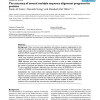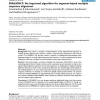291 search results - page 10 / 59 » Progressive multiple sequence alignments from triplets |
BMCBI
2010
13 years 7 months ago
2010
Background: Determining beforehand specific positions to align (anchor points) has proved valuable for the accuracy of automated multiple sequence alignment (MSA) software. This f...
BMCBI
2006
13 years 7 months ago
2006
Background: There have been many algorithms and software programs implemented for the inference of multiple sequence alignments of protein and DNA sequences. The "true" ...
BMCBI
2008
13 years 7 months ago
2008
Background: Multiple sequence alignments are a fundamental tool for the comparative analysis of proteins and nucleic acids. However, large data sets are no longer manageable for v...
BMCBI
2010
13 years 7 months ago
2010
Background: While most multiple sequence alignment programs expect that all or most of their input is known to be homologous, and penalise insertions and deletions, this is not a ...
BMCBI
2005
13 years 7 months ago
2005
Background: We present a complete re-implementation of the segment-based approach to multiple protein alignment that contains a number of improvements compared to the previous ver...


